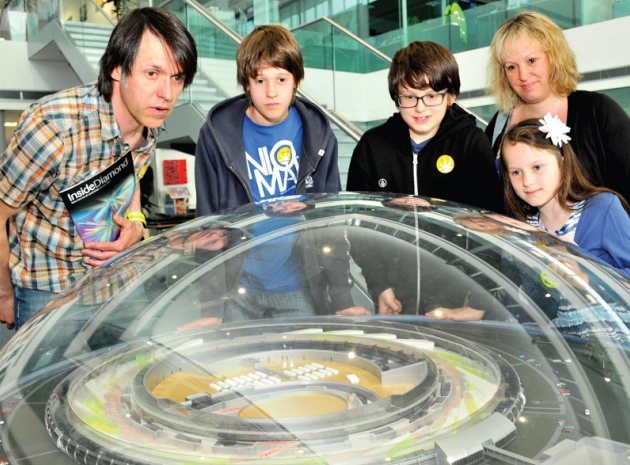Diamond Light Source, where I am chief executive, is one of Britain’s best kept secrets. A giant silver, ring-shaped science facility the size of Wembley stadium located in the Oxfordshire countryside, it is the UK’s ‘synchrotron’ - in other words, a giant X-ray machine that produces a light 10 billion times brighter than the sun. The light that it produces is the brightest in the solar system and allows scientists to study matter at an atomic level and unlock the structures of a variety of matter which has previously not been possible. While Diamond is shedding light on new areas of science every day – and attracts more than 3000 scientists every year - one of its most important roles is inspiring young people, who will be the scientific minds of the future.
A vast range of different research takes place at this futuristic facility. Diamond has been instrumental in myriad scientific advances and discoveries. From aerospace to vaccine design, renewable energy to electronics, Diamond is at the forefront of pioneering science which in future will influence how we produce energy, dispose of waste, combat disease and feed the world’s population.
Engaging young scientists
Apprenticeships are welcomed at Diamond, particularly within the technical division. The Science and Technology Facilities Council (STFC) manages an apprenticeship scheme which has been running successfully for many years. Diamond is a partner in this scheme, giving all the apprentices the opportunity to spend time working at the synchrotron. A popular area at Diamond for apprentices is electronics and electrical engineering. Currently there are three apprentices on site - two electrical apprentices and one mechanical apprentice.
The synchrotron also actively engages with schools and students, from KS2 right up to university undergraduates. Diamond’s scientists give science talks at primary schools, whilst secondary level students visit Diamond for events focussing on biology, engineering, data analysis and physics. Undergraduates can apply for summer internships working at the synchrotron.
Training new scientists is what keeps science alive, and allows new discoveries to be made. PhD students coming to Diamond help to ensure that the next generation of scientists know about the advantages of synchrotrons and what they can offer, which is vital to our continued success. Diamond currently has 51 active PhD studentships and by the end of the year, this number is expected to be around 77. Diamond goes on to support young people early in their careers, by employing PhD students and post-doctoral researchers.
An open approach
When students see Diamond in action, they witness ground breaking science that goes across the compartmentalised ‘boxes’ of subjects that are taught in schools. Chemistry, biology, physics and engineering all rely and progress upon each other’s research. We aim to foster an open-minded approach in young minds, to amplify curiosity rather than narrowing it down too single-mindedly on any one subject.
2015 will see the inaugural Work Scheme Academy at Diamond, initially involving a group of 20 students from local schools, who will spend a week at the facility learning about all areas of Diamond. Previously students would spend their time with just one or two scientists, but we believe this new approach will enable students to gain a greater understanding of how scientists from all areas of research operate at Diamond and how each discipline shares and relies upon research from other fields of science. By marrying an overall experience with more focused project work, the hope is that students will experience and share their ideas from different areas of science, either fostering an existing interest in biology, for example, or potentially stimulating a new interest in engineering or physics.
It’s really important that STEM facilities do engage the public with what they’re doing, because the research they support has an impact that is felt around the world, and talking about it allows people to see how central science is to society. While science continues to shine a light on new discoveries, facilities like Diamond are reliant upon young scientists. We are determined to keep inspiring young minds, showing them not only the cutting edge facilities available, but the breadth of science on offer, keeping that curiosity alive at all ages in UK schools and universities.
About the Author
Professor Andrew Harrison is chief executive at Diamond Light Source (diamond.ac.uk).










